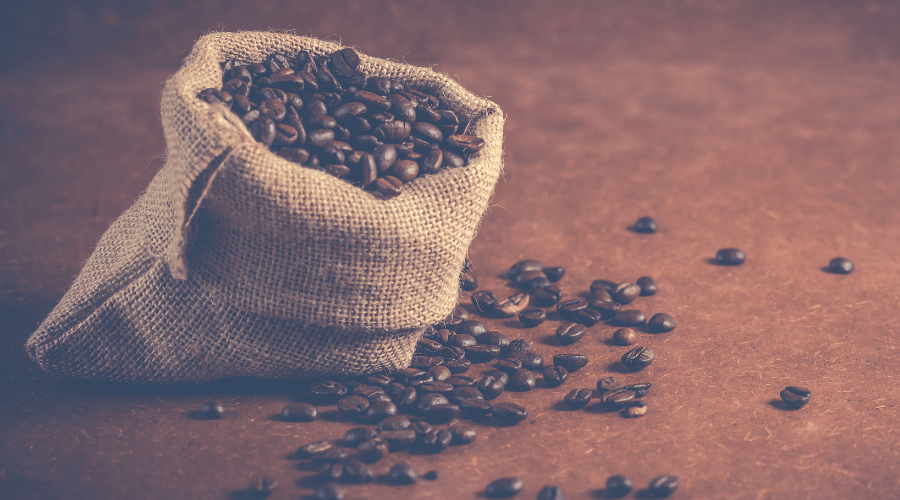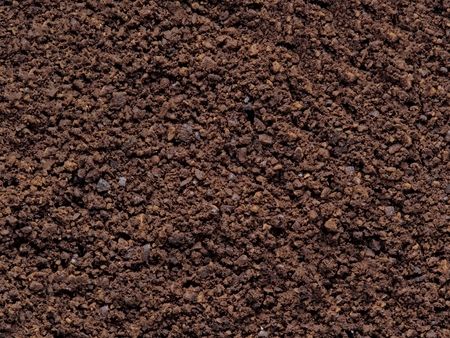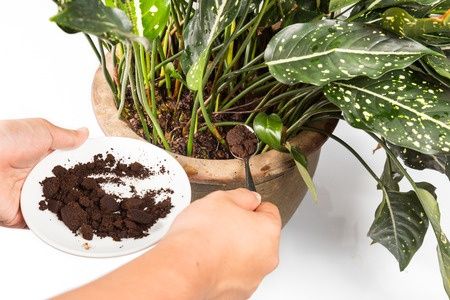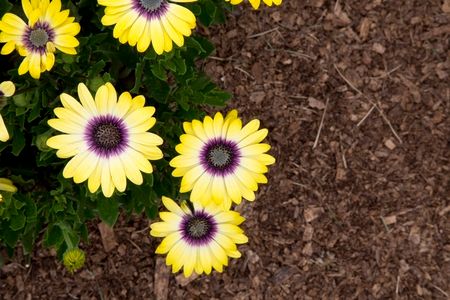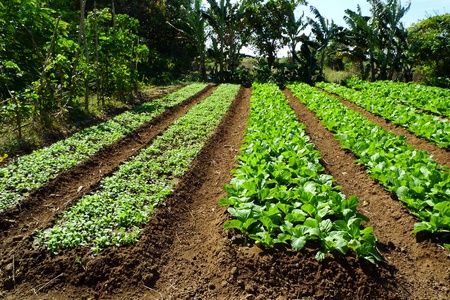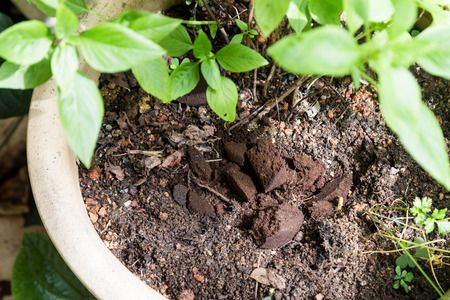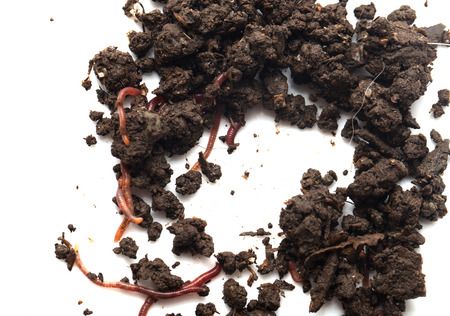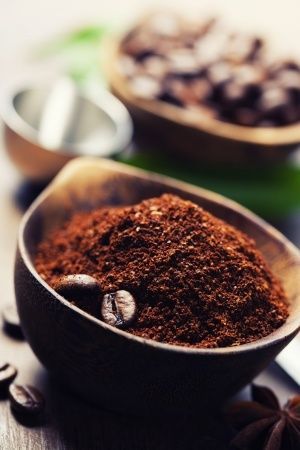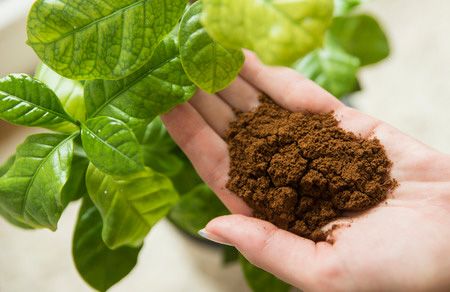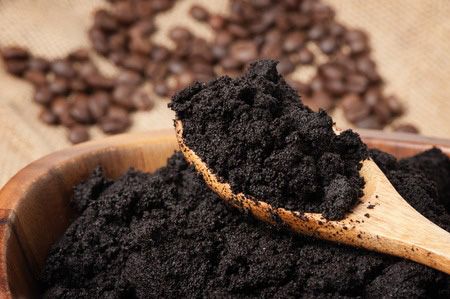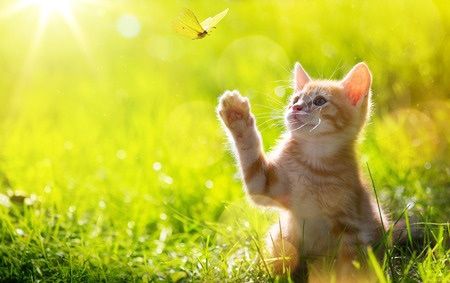Are you looking for a way to give your plants a boost? Do you want to improve the soil in your garden but avoid using man-made chemicals? Adding coffee grounds to your garden is a cheap and eco-friendly way to add nutrients to your soil. Using them for gardening is not a new discovery, but it isn’t used as much as you would think. Many people don’t realize the benefits of adding the waste in your garden.
But are java bits good fertilizer? The research says yes. They can be used for composting, in your vegetable garden and even as lawn fertilizer. Your garden soil can benefit from the leftover coffee grounds you would usually throw away. And if you’re looking for a way to get rid of leftover food or vegetable peelings, then grounds are perfect for composting as well.
I’ve put together all the information you need to know about using coffee grounds for gardening. So read on and discover how you can take this waste product and use it to make your backyard thrive.
USING THEM AS COMPOST
Using your leftover coffee grounds for composting not only helps your compost heap turn leftover food, fruit and vegetable peelings into nutrient-rich garden soil, it also reuses something that would ordinarily be thrown away.
It is much simpler than you think, just throw your coffee bits straight onto your compost pile or throw them (straight from the pot) into your compost bin. The great new is coffee filters are biodegradable as well, so you won’t have to worry about scraping them clean to throw them away.
The leftover bits add nitrogen to your compost pile and will improve the makeup of your garden soil.
The important thing to remember when you are using used grinds for composting, is they are a green compost material – this means that they are high in nitrogen. Other green materials are grass clipping and vegetable peel. In a good compost heap, you want a balance between green compost material and brown compost material. Brown material is high in carbon and includes eggshells, leaves, paper and cardboard. By getting the balance right in your compost heap, and having an equal amount of both, you will make sure you get the best quality garden soil.
To make sure you get the mixture in your compost heap perfect, add a third of leaves, a third of fresh grass and a third used grounds. You should make sure your compost heap is mixed regularly as the different materials need to sit alongside each other as they rot because they feed off each other.
PRO TIP
Starbucks is one of the best places to gather used material for composting. Your local branch is happy to set some aside or give you a load of the used grounds at the end of every day. Just turn up with a clean, dry bucket or bag to put them in. You’re helping them avoid sending more waste to landfill and you get a large, regular supply of brewed coffee bits for your garden. It’s a win-win.
Compost can be stored in a heap or composting bin indefinitely as long as it is mixed well.
USING THEM AS FERTILIZER
Using coffee grounds as fertilizer is a cheap and eco-friendly way to give your garden soil a boost of nutrients. Now it might sound as if you need a Ph.D. in soil management to create your own fertilizer – but this couldn’t be further from the truth. In fact, you can add them directly to your garden soil.
But how do you do this and what is the best way to add them as a fertilizer?
Firstly, you want to get a large bag of coffee grounds (from a Starbucks or coffee shop as mentioned above) and a bag of topsoil.
You can mix equal parts grounds and topsoil to create a potting mixture or, if you are adding to flower beds, you can just sprinkle it straight on top. Take a handful and spread them onto the top of your soil. Make sure you don’t layer it thicker than half an inch or the remains could fuse together and create a solid crust which prevents water from getting through. Use a small fork or a rake to spread the coffee evenly in the garden soil and mix it in with the top layer of your flowerbed.
You can mix topsoil with the java remnants and then spread that in the same way. You could mix it in a large wheelbarrow and then walk it around your backyard, shoveling it out as you go.
If you are adding grounds directly, start with a small amount to test how individual plants react. Start by adding a level tablespoon of grounds once a week and then observe how your plants change or grow. Tweak the amount, or frequency you add them, to suit your plants.
While you may think the black material is too acidic for your garden soil, the brewing process actually removes the acidity but leaves all the nutrients and vitamins your plants will love. The grounds have nitrogen, phosphorous and potassium which are all easily absorbed by garden plants.
Leftover grounds can also be mixed with eggshells to create a perfect, rich fertilizer.
All plants crave nutrients so coffee grounds can be used with many different plants at different levels, further on we will go into which plants benefit from coffee grounds as fertilizer the most.
USING THEM AS MULCH
Using coffee grounds as mulch is a cheap and effective way to perk up your garden soil. Adding them to your garden is a brilliant way to give your soil texture.
As you can tell by just looking at them, the black kitchen waste is easily compacted due to its fine texture. Test this by taking a handful and squeezing them, you will see they quickly form solid lumps. This is brilliant for creating a barrier to moisture and air movement when laid on in a thick layer. Aim for one to two inches to create a water-resistant crust on the top of your soil. To create mulch however.
STEP
Use a thin layer of about half an inch on the top of your garden soil.
STEP
Then cover this with a coarse organic mulch layer, such as wood chips.
The organic material has an excellent reputation for germination of sugar beet seeds, cabbage, and soya beans. These plans react very well to the high nitrogen content at the seed germination stage. The increase in soil temperature, due to the high nitrogen content, allows seeds to germinate quickly and more successfully.
Compared to wood chips, grounds are a much cheaper and eco-friendly option. When you are using coffee remnants as fertilizer, you know it is near PH neutral but woodchips come from a wide variety of trees and it can be very difficult to know the acidity. Some woodchip mulch mixes actually have a bad reaction and will make your soil more acidic. This means using wood chips as a mulch can be riskier than coffee bits.
ADDING THEM TO YOUR SOIL AS A PESTICIDE OR INSECTICIDE
It is one of the main annoyances faced by gardeners. Tending your crops and vegetables only to see them attacked and destroyed by bugs and insects. But using leftover java grinds for gardening can also help you keep unwanted pests out of your backyard. Commercial pesticides are full of chemicals and man-made substances. While they can be effective, pouring a chemical concoction all over your plants or even vegetables can be bad for your health.
They offer a natural alternative. There is a great deal of anecdotal evidence that says they are a great slug repellent. A study in June 2002 for Nature, the journal which studies the natural world, found slugs and snails died after being sprayed with caffeine. While the amount of caffeine needs to be very high (about three times the amount in a regular cup of coffee) there are gardeners around the world that swear by using the material to deter pests.
KEEP THE CATS AT BAY BY ADDING IT TO YOUR GARDEN
While we all love pets, cats can be destructive (and messy!) presence in your backyard. They can dig up your plants and scavenge for food.
It has long been known that adding strong smelling substances to your gardens like orange, pepper or eucalyptus can put our feline friends off from visiting but brewed coffee remnants have the same effect.
While there are plenty of chemical-based products for repelling cats, or even mechanical systems that let of high pitched frequencies, coffee remnants are a more natural and eco-friendly approach to deterring your neighborhood cats. Caffeine is very toxic to cats, however, so caution should be used as to how much is spread about and where; you don’t want to have an unexpected and costly trip to the vet!
VERMICOMPOSTING – LET THE WORMS DO THE WORK
One creature that absolutely loves leftover coffee bits is worms. They are a gardener’s best friend and the use of worms for vermicomposting is a great way to enrich your soil and keep it full of nutrients. Earthworms turn organic waste into extremely high-quality garden soil. A family of worms is the best way to break down your compost heap and vermicomposting systems are a clean and efficient way to break down scraps and garden cuttings.
But why do worms like coffee grounds? It seems strange to think about it, but worms love the taste almost as much as humans. They tuck into kitchen scraps and vegetable waste as happily as if it was made specifically for them.
Worms need gritty food to aid their digestive system which is why the texture of grinds is perfect for them. Their internal organs are helped by the addition of organic grinds which makes them better at munching their way through your compost heap.
One of the recommended ways to attract worms to your compost heap and keep them there, is to line your compost heap with fresh coffee grounds regularly. Researchers at Cornell University discovered this can bring in the bilaterians from all over your garden.
ADDING THEM TO YOUR GARDEN TO SUPPRESS FUNGAL DISEASE
Another little-known fact is that grounds are actually anti microbial.
As the organic material rots in your garden soil, they can stop fungal disease including Fusarium, Pythium, and Sclerotinia. Studies show using them as part of your garden compost can help to prevent diseases from taking hold.
Dangerous bugs like E. Coli and Staphylococcus are also affected by having the black material in your soil and a test was carried out where cheese that was ripening was covered in grounds showed it slowed or stopped, the growth of harmful bacteria.
Beans, cucumbers, spinach, and tomato plants have all been tested with grounds and it has been proven that they stop the disease.
WHICH PLANTS LOVE THE BLACK WASTE?
The material can be used on hundreds of different plants and shrubs but there are some that react better than others.
Adding it to your garden improves the texture of your garden soil as well as the ability to drain away water after heavy rainfall. As they decompose, coffee grounds add nitrogen, potassium and phosphorous to the soil so any plants which need a rich source of these vitamins will react well to added coffee grounds.
Nitrogen craving vegetable plants include tomatoes, corn, spinach, and any leafy vegetable. Plants like roses, camellias, rhododendrons, and azaleas also thrive in nitrogen-rich soil.
Adding the organic waste to your vegetable garden can really give your crops a boost and you can be safe in the knowledge you are using only all-natural compost and fertilizer so the food you harvest from your backyard will be chemical and pesticide free.
USING IT FOR TOMATOES
Using the bitter material on your tomato plants can really give them a boost.
Tomatoes need nitrogen rich soil to grow healthy and strong fruit so coffee bits, with their high nitrogen content, are perfect. This helps the roots grow strong and boosts the tomato plant’s ability to produce chlorophyll – key for photosynthesis.
Coffee grounds are an eco-friendly fertilizer and also attract earthworms which will boost the soil around your tomato plants. Slugs, which are naturally attracted to tomato plants, will also be repelled by the used grounds.
The best way to use coffee grounds for your tomato plants is to mix it within your compost or topsoil to add the nutrients evenly through the mixture.
USING IT AS A LAWN FERTILIZER
Using the household material to make your grass greener might sound a little crazy, but the evidence shows it is very effective. And stronger grass means fewer weeds you’ll need your string trimmer for.
Grass loves grinds and it will make your lawn look greener and lusher.
The easiest way to spread coffee grounds is to do it when you water your grass. Mix around half a pound of coffee grounds with five gallons of water and you’ve got an inexpensive, and easy, lawn fertilizer. This way you won’t have the worry of clumps of coffee grounds scattered all over your lawn and you will make sure it spreads evenly by using a watering can to sprinkle the lawn.
You could also spread the leftover material by hand and then use a rake to evenly distribute the clumps of coffee. You should make sure it falls down between the grass and onto the soil itself which will make sure it adds nutrients rather than just sitting on the top.
If you’re composting, just add coffee grounds to your compost heap and once you have allowed it to break down and become a rich, well-mixed compost, you can use the compost with grass seed to cover any bald patches on your grass. The coffee in the compost will help keep the whole mixture moist and will help the grass seeds grow. It usually takes around three months to create a well-rotted compost mixture.
THEY ARE GREAT AS A FERTILIZER FOR ROSES
Rose bushes are one of the flowers that absolutely love coffee bits. These difficult to grow plants are boosted by the high nitrogen content in coffee grounds and by adding coffee grounds to your garden soil, you can loosen the texture and give your rose bush more room to grow. With with these benefits, and the fact coffee repels bugs, it is a great way to help your roses out.
But how do you make fertilizer for your rose bushes? You can just add the coffee grounds straight to compost as explained above, or even just sprinkle the dried grounds at the bottom of your rose bush.
Another method, similar to how you would use it on a lawn, is to mix the coffee grounds with water and pour it on your rose bush around once or twice a month.
BLUEBERRIES BENEFIT, TOO
The household waste can also boost blueberry plants. These hardy little plants don’t usually need fertilizer but they do get a boost from coffee grounds.
Like the nitrogen loving tomato plant, these berries thrive in a high nitrogen environment.
You can add the grinds straight to the soil with these plants. Just add four or five cups to the ground around your bush and then mix it well with the top layer of soil. This can be done as often as every two weeks.
HYDRANGEAS LOVE THEM!
Another beautiful flower which loves coffee grounds is the hydrangea. This plant benefits from the magic of coffee grounds.
They will change and improve the color of your flowers as the nutrients added by coffee grounds improve the plant. You will see brighter and more vivid colours on your hydrangeas just by sprinkling some coffee grounds into the top layer of soil or even mixing them with water and pouring over.
THE ACID TEST – COFFEE GROUNDS AND ACIDITY
There are lots of conflicting reports online about the acidity of coffee grounds. And you’ll be surprised to hear that there is a simple explanation.
Unused material (that have not been brewed or watered down) are acidic. But on the PH scale, which is used to determine how acidic or alkaline a substance is, a black coffee only measures 5. Numbers under 7 are acidic and above are more alkaline. 7 is neutral.
But the common mistake is to think that they remain at this PH after brewing. Once the grounds have been used in your morning cup of coffee, they are actually reduced and the PH level of used coffee grounds are about PH 6.5 or 6.8 – making them very close to neutral.
Of course, acidity changes marginally between different strengths of coffee so choosing a lower strength will see a lower pH level.
And different methods of brewing have an effect too. Using a coffee maker or cafeteria with hot water will remove much more of the acidity from coffee grounds than the newly-popular method of “cold brewing”. As cold brewing isn’t as harsh on the coffee as using hot water, the pH level won’t change as dramatically.
WHEN NOT TO USE THEM IN YOUR GARDEN
As mentioned above, cats don’t like coffee. And, in fact, it is very bad for them so if you have a pet cat it might be best to steer clear of scattering grinds directly onto your soil. A little mixed with compost, where it is unlikely to come into contact with your pet, could be alright. Just make sure you dig the grounds into the soil well to prevent too much of it getting onto your cat’s fur or paws.
CONCLUSION
So hopefully this list has helped you find out more about using organic material like coffee bits and gardening. We’ve gone over the pros and cons of adding grounds to the garden as well as adding some handy how-to guides for making the best lawn fertilizer, using coffee grounds for composting and putting coffee grounds in your garden soil.
Bringing earthworms into your garden, by using used toffee bits, will also make sure you have the best quality soil and give your plants every opportunity to flourish. They can also stop unwanted pests like slugs from damaging your crops and the caffeine content in coffee remnants will even keep neighborhood cats at bay.
When you are thinking about how to make sure your garden thrives and your plants look their best, these tips are invaluable to bear in mind. So if you have gotten some new information from this list, please comment below and share this article around with any friends and family that are looking for a way to boost their backyards.
Let us know how you do with adding grounds to your garden in the comments section and please share any tips you might have. Happy gardening!

